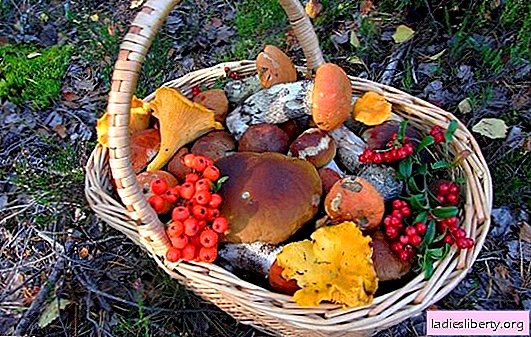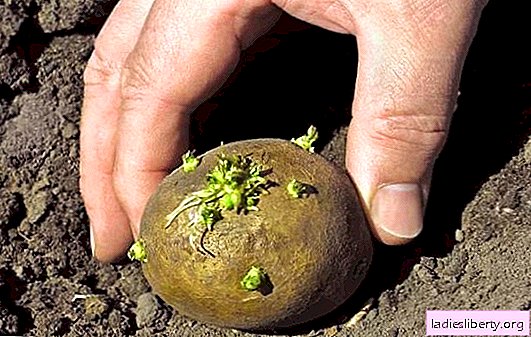
Mushrooms - a separate kingdom of wildlife, among a huge variety of about 100 species is considered edible. This is almost the most common group of living organisms, which is located in the air, land and underwater space. Mycologists distinguish from 100 to 250 thousand species of various mushrooms. In each region, individual species of forest (wild) mushrooms predominate, but there are the most famous species that are considered useful.
Useful properties of mushrooms
All mushrooms are low-calorie foods, on average, fresh forest mushrooms contain 20-30 kcal / 100 grams of product. Useful mushrooms practically does not contain starch and cholesterol, helps the body remove excess fluid, which is facilitated by the presence of potassium.
Fresh mushrooms contain from 80% to 90% water, the rest is plant proteins, vitamins, minerals, chitin, which interferes with the full absorption of proteins. Chitin is mainly found in mushroom legs, so it is recommended to use only hats for food or thoroughly peel the legs.
• vitamins B1, B2, PP, D;
• potassium, calcium, copper, zinc, phosphorus;
• fats and fatty acids up to 0.8%, they are well absorbed;
• interchangeable and essential amino acids (lysine, threonine, tryptophan);
• resins and essential oils (terpenes), which give the mushrooms a unique forest aroma.
Vitamins and minerals have a general strengthening effect, improve the nervous system. They have a prophylactic effect in cardiovascular and endocrine diseases. In boiled and dried form, mushrooms retain a significant portion of useful and nutrients. They cause increased gastric secretion, increase appetite and promote the digestion of other foods.
What are the most useful mushrooms
It is possible to conditionally divide useful mushrooms into forest and greenhouse ones, but on modern plantations all types of forest mushrooms are grown. So the mushroom products in frozen and pickled form, which is sold in supermarkets (porcini mushrooms, mushrooms and others) are clearly not of forest origin.
1. Tubular (spongy) mushrooms, they have a soft thick hat, consisting of two layers, one of which is easily detachable and looks like a sponge.
• Ceps (boletus) - a valuable source of protein and dietary fiber. The alkaloid herzedin and lecithin are necessary for the prevention of angina pectoris and the strengthening of the cardiovascular system. Riboflavin promotes hair and nail growth, stimulates skin renewal. Sulfur and polysaccharides regulate the proper functioning of the thyroid gland. Ceps contain tocopherol (vitamin E), thiamine (vitamin B1), niacin (vitamin B3 or PP), folic acid.
• Birch bark - fragrant, tasty mushrooms, contain vitamins of groups B, E and D, nicotinic acid. The trimmers have a balanced protein composition (glutamine, leucine, arginine, tyrosine). They help to remove toxins from the body due to the large amount of dietary fiber. A large amount of phosphoric acid helps to strengthen the musculoskeletal system. Dried boletus mushrooms are used to regulate blood sugar levels in the treatment of renal pathologies.
• Boletus - in terms of taste and nutritional properties they are almost inferior to porcini mushrooms. They contain a lot of iron, potassium, phosphorus, lecithin and fatty acids. There are as much vitamin B in boletus as in cereal plants, and as much nicotinic acid as in some types of liver. If dried boletus is finely ground or ground into powder, then their nutritional value will increase many times, they can be used to normalize cholesterol, to restore the body after illness or in the postoperative period.
2. Agaric mushrooms - bottom of the cap are plates that are arranged in the form of radial rays from the legs to the edges of the cap.
• Gruzdi - have long been known on the Eurasian continent, served at the royal table. Natural source of vitamin D of non-animal origin. Fermented (salty) breasts remove toxins and toxins, normalize the kidneys, cleanse the urinary system, and prevent the deposition of salts in the joints. In fermented breasts after the natural fermentation process, beneficial bacteria appear that improve the microflora in the gastrointestinal tract and prevent the spread of pathogenic microbes.
• Ginger - popular popularity among these mushrooms arose deservedly. The unique taste and wonderful aroma of these mushrooms can cause appetite in any person. One of the most digestible mushrooms, saffron milk contains many B vitamins (thiamine, riboflavin and niacin). Mineral salts are useful for normal metabolism and the elimination of symptoms of joint diseases. A bright red color in mushrooms is obtained due to the high content of beta-carotene - it is a natural antioxidant that can stimulate the immune system and increase the protective properties of the body.
• Honey mushrooms - placers of these fungi are often found in clearings or clearings, where there are many old stumps. Thick “autumn” honey mushrooms are compared even with porcini mushrooms - tasty, fragrant, require a minimum of cleaning and heat treatment, quickly and easily cooked. These mushrooms are rich in vitamins B and C and 1, contain potassium, sodium, magnesium and iron. Beneficial effect on the condition of the intestine, eliminate E. coli and Staphylococcus aureus. Useful for coronary disease and diabetes. 100 grams of honey agarics replenishes the daily requirement of the body for honey and zinc. By the content of calcium and phosphorus, honey agarics are not inferior to some types of fish. They are well absorbed and add strength for a long time.
• Oyster mushrooms - inconspicuous, modest mushrooms have many useful properties. They contain vitamins of groups E, B, C and a rare vitamin D2, which is necessary in the process of assimilation of calcium and phosphorus in the intestine. Most other fungi contain nicotinic acid (vitamin B3), which accelerates metabolic processes and is involved in cell renewal. Oyster mushrooms have bactericidal properties, normalize blood pressure, lower the level of "bad" cholesterol in the blood, strengthen blood vessels. 100 grams of oyster mushroom is enough to deliver the daily rate of potassium.
• Chanterelles - have a delicious delicate taste. In addition, they have many valuable nutritional qualities - they have an immunostimulating and antitumor effect. Beneficial effect on the condition of the mucous membranes, restore the cells of the stomach and pancreas. They also contain beta-carotene, a large amount of copper and zinc, are a source of essential amino acids. Natural antibiotics in chanterelles stop the spread of staphylococcus aureus and tubercle bacillus. An extract from chanterelles is used for liver diseases and to improve hematopoietic function.
• Mushrooms - an affordable, everyday option, used for salads, pastries, first and second courses. They require a minimum of effort for cooking - a few minutes in a pan with butter and a portion of delicious, fragrant mushrooms is ready. They contain many vitamins, for example, group B more than in many vegetables. Mineral salts help restore water-salt balance and reduce swelling. Amino acids improve brain activity, improve memory, relieve depression and fatigue.
How to eat healthy mushrooms
Mushrooms must be harvested and stored under strict deadlines, as this is a soft, perishable product. They are sold only for certain species, mushroom mixtures are prohibited, because each species requires special preparation and preparation. So, if you collected mushrooms, then do not postpone their cleaning and sorting for more than 5-6 hours.
They can be cooked, fried, baked, prepared for long-term storage (dried, frozen, canned). Daily intake should not exceed 100-150 grams per adult. Mushrooms are contraindicated for children under 3 years old, and up to 14 years old are allowed with great care. It is better to refrain from eating mushrooms for digestive disorders or exacerbation of chronic diseases.











